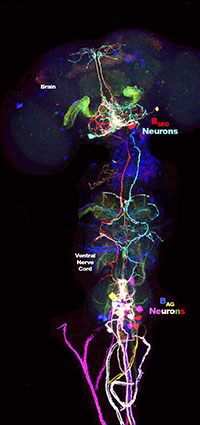Section on Neural Function (SNF)

neurons in the fruit fly
nervous system that express
the hormone, Bursicon.
Neurons are individually
labeled in different colors.
Brains exist to generate behavior. Understanding how they accomplish this task is a primary interest of the Section on Neural Function (AKA, the White Lab). Working on the relatively small brain of the fruit fly, Drosophila melanogaster, we seek to understand how the brain integrates information from the environment and the body to make behavioral decisions. We also seek to understand how the brain executes those decisions by generating appropriate actions. To answer these questions, we use genetic tools to make targeted manipulations of brain activity in living, behaving animals. These manipulations allow us to identify and characterize the brain networks underlying behavioral processes. Developing tools to facilitate this research is another major goal of our laboratory.
Our behavioral research focuses on the specific motor sequences performed by fruit flies during molting. Molting sequences (also called “ecdysis sequences”) represent a simple, tractable model for studying the neuromodulatory mechanisms that govern behavior, and the questions we seek to answer are fundamental to nearly all animal behaviors. The fly has repeatedly proved to be an excellent model for studying biological processes common to all animals (exemplified most recently by the award of the 2017 Nobel Prize in Physiology or Medicine to fly researchers who elucidated the molecular mechanisms of circadian rhythms), and our hope is that the mechanisms of behavioral control that we discover in the fly will deliver insights into the general operation of all nervous systems, including our own.

